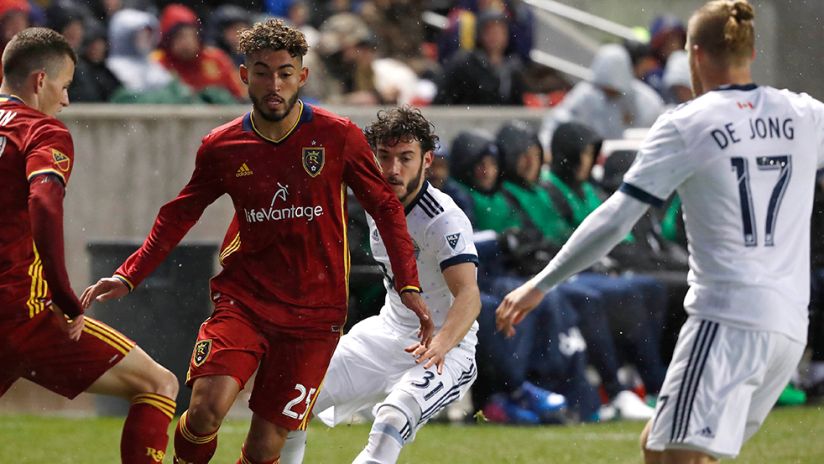A few weeks back, Real Salt Lake reposted an image of three of their players riding in a van at the US national team's January camp. Danny Acosta, Justen Glad and Brooks Lennon each play a different position – left back, center back and winger, respectively – but share two notable attributes: their age (20 years old) and MLS experience.
These three players – regular contributors – from the same team, worked into the national team together before they were old enough to drink. It made news quite precisely because it was news; that's not something we see often stateside.
Still rare is the on-field investment RSL has shown. While clubs like FC Dallas and the New York Red Bulls have also notably established themselves in the youth space – with Bundesliga giant Bayern Munich terming their recent partnership with FCD “a unique alliance between two historic teams at the forefront of youth development” and RBNY feeling confident enough to ship out the captain two years running – there’s been a consistent push from fans and pundits around MLS: #PlayYourKids.
People are hoping to see young players get more opportunities to show their ability and to grow as players. I’m one of those people – “potential” is an arousing concept – but not one to blame coaches for shying away from fielding new pros.
There’s a clear obstacle to putting them on the field: A young player is rarely outright better than the veteran he is competing against. It takes a leap of faith from a manager to give a player his first appearances, to do something that could hurt the team's short-term performance. Whether it's time for a manager to do that is for another column. But I’ve been around coaches and teams my whole life – almost all of them have wanted to give young players opportunities.
Here are four areas for the kids to focus so they can help make that the logical choice:
Transition moments
Most 18-year-olds can pass and trap as well as the 28-year-old. What they need to show is an ability to transition from play-to-play. When the ball goes out of bounds or turns over, young players often relax for a second; they turn their brain off and don’t immediately think about the next action. Meanwhile, the guy next to them is moving to the next play and getting a step ahead.
Soccer is a sport frequently decided on those transition moments. The best chance to win the ball back is as soon as you lose it; the best chance to score, as soon as you win it. Once teams recover their defensive shape, it’s hard to create chances. Never taking a break, always maintaining focus on the present action, that's the biggest change in moving from a youth team to a professional team.
Consistency
Even if we established that young players generally aren’t as good as older players, it's not entirely true: some days, the 18-year-old is the best player on the field. Sometimes his or her skill shines – it can be incredible. Other days, he’s the worst player on the field. Overwhelmed by the pace, or lacking confidence, young players are prone to huge swings in performance.
This leaves the coach to set his lineup, guessing whether he'll field the good version or the bad. It might seem worth the risk from the stands, but we need to remember coaches are prideful people and work hard to create a coherent plan. They have faith in that strategy, believing that if executed properly, it will work. Sometimes coaches are more comfortable playing the less “exciting player” because they know what they will get and can plan for that.
That “trust” – knowing the player will execute the asks – is crucial.
Tactical detail
New pros often aren't as attuned to tactical detail as their veteran temmates: Teenagers step forward a yard behind their line or forget to tuck in on the weak side. That discipline comes with repetition. How do we ask a coach to pick 11 players to execute a system if one of the players can’t be reliably counted on?
It’s a crappy cycle: a player is not meeting the coach's standard, which keeps him off the field, but the only way to get better is on it. That attentiveness can mean the difference between a blown opportunity and a break.
Gamesmanship
You can play the game, and you can win the game. Sometimes those concepts go hand-in-hand, and the player or team who is better at “playing soccer” wins the game. Sometimes they don’t; sometimes one player or team simply knows how to win the game without being technically (or aesthetically) better on the day.
Young players rarely know how to achieve the latter result, lacking the fine details of gamesmanship that don’t provide style points, but generally contribute to the standings. It’s the type of stuff you can only learn when the games have real consequences:
For example, when my team is winning and I want to clear the ball to stop the opponent’s attack, the move isn't launching the ball to Row Z, but rather smashing it into the advertisement boards along the sideline.
The ball ricochets off the board and re-enters the field of play, slowing the opponent’s attack, taking seconds off the clock – all allowing my team to regain our shape. It sounds so small, but that can squeak out points and ultimately change the standings at the end of the year. It’s not a skill you can teach; it’s just a thing you pick up after years of situational experience.
Smart soccer people generally say it’s better to focus on quality of play rather than winning in the youth ranks. I agree. But there’s a point when a player needs to learn the art – coaches need players who can play and win. Giving up style to just get it done, that can earn quick buy-in from the boss.













